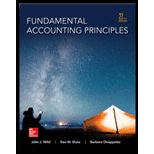
Concept explainers
Introduction:
Equivalent units: Equivalent unit is the product unit that is physically not completed but it is measured as equivalent to completed unit.
Weighted average method: Weighted average method is one of the methods of process costing, under this method the cost of beginning work in process is mixed with the current period cost and weighted cost and equivalent units are calculated. In other words, the weighted average method does not teat the beginning work in process cost separately.
Requirement-1:
To Calculate: The equivalent units of production for the forming department using the weighted average method
Requirement-2:
To Calculate: The cost per equivalent unit of production using weighted average method
Requirement-3:
To Calculate: The Costs assigned to units and transferred and units in ending work in process using weighted average method
Want to see the full answer?
Check out a sample textbook solution
Chapter 20 Solutions
Fundamental Accounting Principles -Hardcover

 AccountingAccountingISBN:9781337272094Author:WARREN, Carl S., Reeve, James M., Duchac, Jonathan E.Publisher:Cengage Learning,
AccountingAccountingISBN:9781337272094Author:WARREN, Carl S., Reeve, James M., Duchac, Jonathan E.Publisher:Cengage Learning, Accounting Information SystemsAccountingISBN:9781337619202Author:Hall, James A.Publisher:Cengage Learning,
Accounting Information SystemsAccountingISBN:9781337619202Author:Hall, James A.Publisher:Cengage Learning, Horngren's Cost Accounting: A Managerial Emphasis...AccountingISBN:9780134475585Author:Srikant M. Datar, Madhav V. RajanPublisher:PEARSON
Horngren's Cost Accounting: A Managerial Emphasis...AccountingISBN:9780134475585Author:Srikant M. Datar, Madhav V. RajanPublisher:PEARSON Intermediate AccountingAccountingISBN:9781259722660Author:J. David Spiceland, Mark W. Nelson, Wayne M ThomasPublisher:McGraw-Hill Education
Intermediate AccountingAccountingISBN:9781259722660Author:J. David Spiceland, Mark W. Nelson, Wayne M ThomasPublisher:McGraw-Hill Education Financial and Managerial AccountingAccountingISBN:9781259726705Author:John J Wild, Ken W. Shaw, Barbara Chiappetta Fundamental Accounting PrinciplesPublisher:McGraw-Hill Education
Financial and Managerial AccountingAccountingISBN:9781259726705Author:John J Wild, Ken W. Shaw, Barbara Chiappetta Fundamental Accounting PrinciplesPublisher:McGraw-Hill Education





